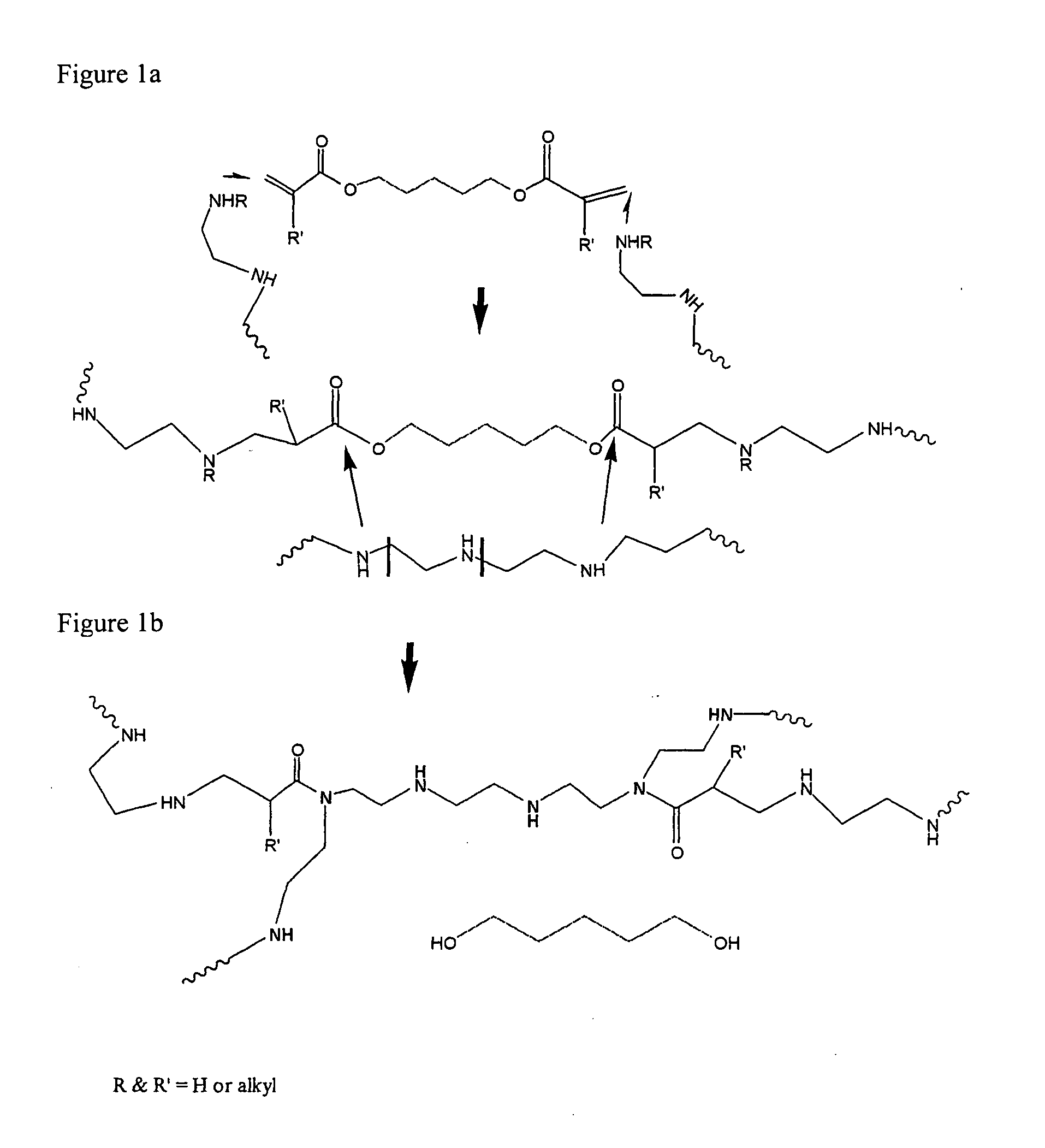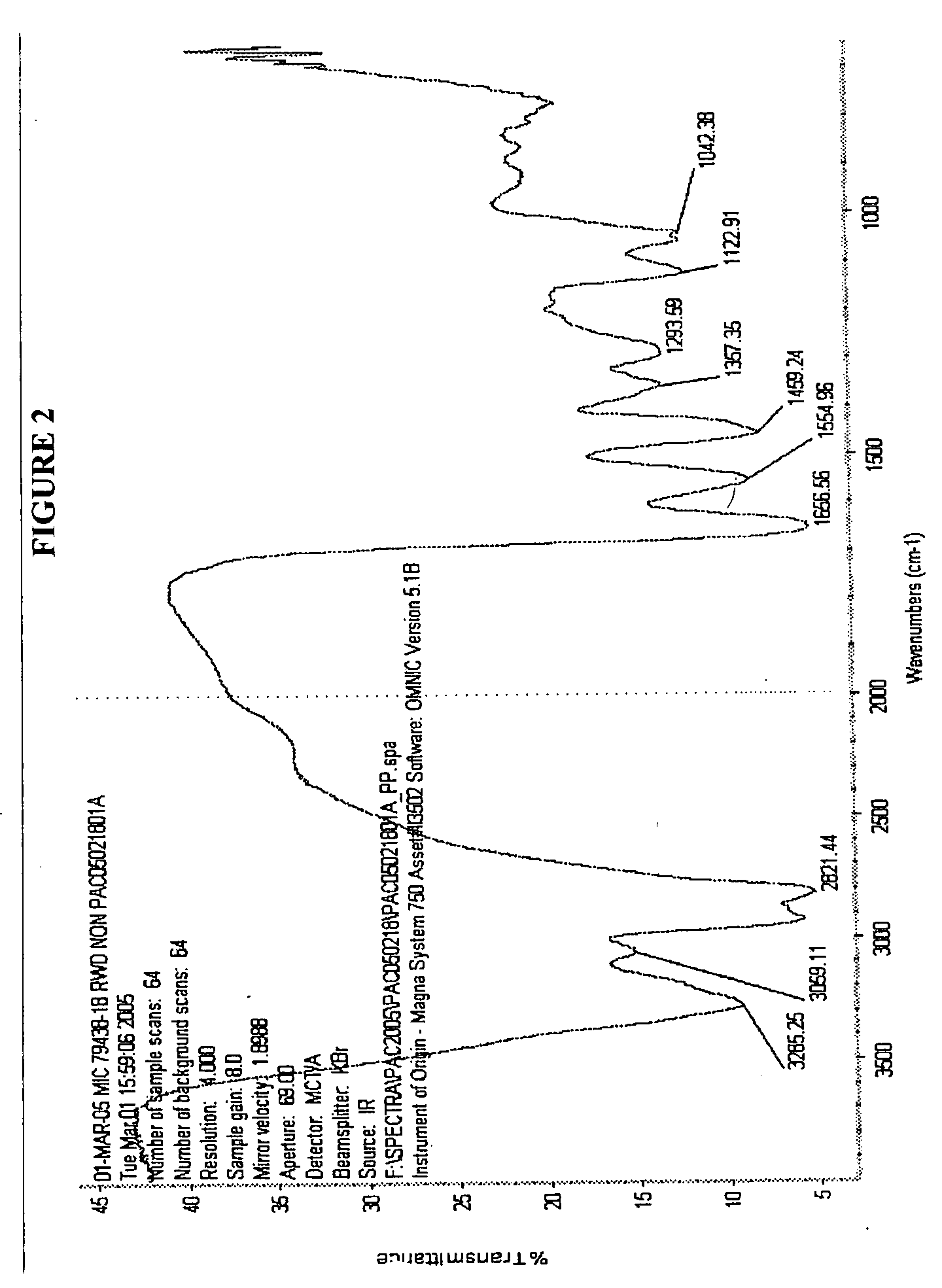CHEMICALLY MODIFIED POLYCATION POLYMER FOR siRNA DELIVERY
a technology of polycation polymer and sirna, which is applied in the direction of biochemistry apparatus and processes, organic active ingredients, gene materials, etc., can solve the problems of bursting of the vesicle and releasing its content into the cytoplasm, necrosis and apoptosis, and no substantial gene expression knockdown can be observed, so as to achieve the effect of lowering the expression of a gen
- Summary
- Abstract
- Description
- Claims
- Application Information
AI Technical Summary
Benefits of technology
Problems solved by technology
Method used
Image
Examples
example 1
Synthesis of the Carrier OEI-HD-1
[0078]5.0 g (0.0063 moles) of polyethylene imine (weight average molecular weight 800) were dissolved in 7.5 ml of DMSO. In a separate container, 3.3 ml of DMSO and 1.4 ml=1.4 g (0.0063 moles) 1,6 hexanediol diacrylate were added. Both solutions were mixed. In a 50 ml round bottom flask immersed in oil bath thermostated at 60 degrees C. and fitted with a magnetic stir bar. The flask was loosely stoppered and allowed to react for 4 days. Then the reaction solution was added dropwise to 200 ml of a rapidly stirred solution of ethyl acetate whereby a viscous material formed on the bottom and sides of the flask. The solvent was decanted off and a fresh 200 ml aliquot of ethyl acetate was added and the materials mixed. This was decanted again and an additional 100 ml aliquot was added, mixed and decanted leaving behind the viscous material. The material was transferred to a boat made from aluminum foil and it was placed in a vacuum oven at room temperatur...
example 2
Purification of OEI-HD-1 by Dialysis
[0079]Weighted out 0.80 g of OEI-HD-1 and added it to a scintillation vial followed by 10 ml of Dulbucceos PBS buffer. It dissolved after a short time with shaking. Preconditioned about I linear foot of Spectrum 3500 cut-off dialysis membrane (0.4 ml / cm of length capacity) by boiling it in a beaker of distilled water for about 10 minutes. Then a knot was tied in one end of the dialysis tubing and the OEI-HD-1 solution was added and sealed by tying a knot in the other end. The tube was placed in approximately 3 gallons of distilled water and the water was stirred gently for 4 days. After that the material was removed from the tubing and freeze dried yielding about 30 percent of the polymer mass that was added to the tubing. Proton and Carbon 13 NMR were run on this product.
example 3
Precipitation of OEI-HD-1 into Dioxane
[0080]Example 1 is repeated but instead of using ethyl acetate for washing, dioxane was substituted. The use of dioxane avoids the possibility of acetylation of free amines by the ethyl acetate ester.
PUM
| Property | Measurement | Unit |
|---|---|---|
| weight average molecular weight | aaaaa | aaaaa |
| weight average molecular weight | aaaaa | aaaaa |
| weight average molecular weight | aaaaa | aaaaa |
Abstract
Description
Claims
Application Information
 Login to View More
Login to View More - R&D
- Intellectual Property
- Life Sciences
- Materials
- Tech Scout
- Unparalleled Data Quality
- Higher Quality Content
- 60% Fewer Hallucinations
Browse by: Latest US Patents, China's latest patents, Technical Efficacy Thesaurus, Application Domain, Technology Topic, Popular Technical Reports.
© 2025 PatSnap. All rights reserved.Legal|Privacy policy|Modern Slavery Act Transparency Statement|Sitemap|About US| Contact US: help@patsnap.com



